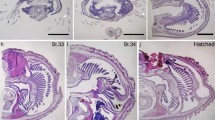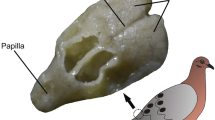Summary
Photoreceptor cells in the epidermis and nerve branches of the prostomium and in the cerebral ganglion of Lumbricus terrestris were investigated with the electron microscope. The photoreceptor cell is similar to the visual cell of Hirudo by having a central intracellular cavity (phaosome) filled with microvilli. Besides microvilli, several sensory cilia can also be found in the phaosome but they are structurally independent of the microvilli. A gradual branching of the phaosome cavity into smaller cavities makes its sectional profile extremely labyrinthic. Flattened smooth-surfaced cisternae in stacks of 2 to 5 are frequently observed around the phaosome. Characteristic constituents of the cytoplasm are vesicles and vacuoles filled with a substance of varying density. The photoreceptor cell is covered by glial cells or by their processes which at many places deeply invaginate the cell surface (trophospongium).
Zusammenfassung
Die Feinstruktur der Photorezeptorzellen in der Epidermis, in kleineren Nervenästen und im Zerebralganglion von Lumbricus terrestris wurde untersucht. Das Vorhandensein eines zentralen, intrazellulären Lumens (Phaosom), das mit Mikrozotten gefüllt ist, erinnert in der Struktur der Photorezeptorzelle des Regenwurms an Lichtsinneszellen von Hirudo. Außer Mikrozotten findet man im Phaosom einige Zilien vom Typ 9×2+0; solche Zilien sind von den Mikrozotten strukturell unabhängig. Durch eine Aufzweigung des Phaosoms in kleinere Buchten, die tief in das umgebende Zytoplasma eindringen, erhält es ein labyrinthartiges Aussehen.
Glatte Zisternen in Gruppen von 2 bis 5 wurden oft um das Phaosom im Zytoplasma beobachtet. Charakteristische Bestandteile der Zelle sind noch Vesikel und Vakuolen, die mit einer Substanz von wechselnder Elektronendichte gefüllt sind. Die Photorezeptorzellen werden von Gliazellen und Gliafortsätzen umgeben, die an vielen Stellen die Zelloberfläche tief einstülpen (Trophospongium).
Similar content being viewed by others
References
Barer, R., Sidman, R. L.: The absorption spectrum of rhodopsin in solution and in intact rods. J. Physiol. (Lond.) 129, 60–61 (1955).
Bennett, H. S., Luft, J. H.: Collidine as a basis for buffering fixatives. J. biophys. biochem. Cytol. 6, 113–114 (1959).
Brown, P. K., Wald, G.: Visual pigments in single rods and cones of the human retina. Science 144, 45–52 (1964).
Clark, A. W.: The fine structure of the eye of the leech, Helobdella stagnalis. J. Cell Sci. 2, 341–348 (1967).
Denton, B. J., Wyllie, J. H.: Study of the photosensitive pigments in the pink and green rods of the frog. J. Physiol. (Lond.) 127, 81 (1955).
Dhainaut-Courtois, N.: Sur la présence d'un organe photorécepteur dans le cerveau de Nereis pelagica L. (Annélide polychète). C. R. Acad. Sci. (Paris) 261, 1085–1088 (1965).
Dorsett, D. A., Hyde, R.: The fine structure of the lens and photoreceptors of Nereis virens. Z. Zellforsch. 85, 243–255 (1968).
Eakin, R. M.: Lines of evolution of photoreceptors. J. gen. Physiol. 46, 357A-367A (1962).
—: Lines of evolution of photoreceptors. In: General physiology of cell specialization. New York McGraw-Hill Book Co. 1963.
—: Evolution of Photoreceptors. Cold Spr. Harb. Symp. quant. Biol. 30, 363–370 (1966).
—: Evolution of Photoreceptors. In: Evolutionary biology. New York: Appleton-Century-Crofts 1968.
—, Westfall, J. A.: Further observations on the fine structure of some invertebrate eyes. Z. Zellforsch. 62, 310–332 (1964).
Fischer, A., Brökelmann, J.: Das Auge von Platynereis dumerilii (Polychaeta). Sein Feinbau im ontogenetischen und adaptiven Wandel. Z. Zellforsch. 71, 217–244 (1966).
Hansen, K.: Elektronenmikroskopische Untersuchung der Hirudineen-Augen. Zool. Beitr. N.F. 7, 83–128 (1962).
Hermans, C. O.: Fine structure of the segmental ocelli of Armandia brevis (Polychaeta: Opheliidae). Z. Zellforsch. 96, 361–371 (1969).
—, Cloney, R. A.: Fine structure of the prostomial eyes of Armandia brevis (Polychaeta: Opheliidae). Z. Zellforsch. 72, 583–596 (1966).
Hesse, R.: Untersuchungen über die Organe der Lichtempfindung bei niederen Thieren. I. Die Organe der Lichtempfindung bei den Lumbriciden. Z. wiss. Zool. 61, 393–419 (1896).
—: Untersuchungen über die Organe der Lichtempfindung bei niederen Thieren. III. Die Sehorgane der Hirudineen. Z. wiss. Zool. 62, 671–707 (1897).
Jung, D.: Bau und Feinstruktur der Augen auf dem vorderen und hinteren Saugnapf des Fischegels Piscicola geometra L. Zool. Beitr., N.F. 9, 121–172 (1963).
Karnovsky, M. J.: A formaldehyde-glutaraldehyde-fixative of high osmolality for use in electron microscopy. J. Cell Biol. 27, 137A-138A (1965).
Kernéis, A.: Ultrasturcture des photorécepteurs de Dasychone (Annélides, Polychètes, Sabellidae). J. Microscopie 7, 40a (1968).
—: Nouvelles données histochimiques et ultrastructurales sur les photorécepteurs ≪branchiaux≫ de Dasychone bombyx (Dalyell) (Annélide Polychète). Z. Zellforsch. 86, 280–292 (1968).
Krasne, F. B., Lawrence, P. A.: Structure of the photoreceptors in the compound eyespots of Branchiomma vesiculosum. J. Cell Sci. 1, 239–248 (1966).
Langer, H., Thorell, B.: Microspectrophotometry of single rhabdomeres in the insect eye. Exp. Cell Res. 41, 673–677 (1966).
Liebman, P. A.: In situ microspectrophotometric studies on the pigments of single retinal rods. Biophys. J. 2, 161–178 (1962).
Manaranche, R.: Sur la présence de cellules d'allure photoréceptrice dans le ganglion cérébroide de Glycera convoluta (Annélide Polychète). J. Microscopie 7, 44a (1968).
Röhlich, P.: Fine structure of photoreceptors under normal and experimental conditions. Thesis [in Hungarian] Budapest, 1967.
—, Török, L. J.: Elektronenmikroskopische Beobachtungen an den Sehzellen des Blutegels, Hirudo medicinalis L. Z. Zellforsch. 63, 618–635 (1964).
Walther, J. B.: Single cell responses from the primitive eyes of an annelid. In: The functional organization of the compound eye. Wenner-Gren Center Internat. Symp. 7, 329–336 (1965). Oxford: Pergamon Press 1966.
White, R. H., Walther, J. B.: The leech photoreceptor cell: ultrastructure of clefts connecting the phaosome with extracellular space demonstrated by lanthanum deposition. Z. Zellforsch. 95, 102–108 (1969).
Yanase, T., Fujimoto, K., Nishimura, T.: The fine structure of the dorsal ocellus of the leech, Hirudo medicinalis. Mem. Osaka Gakugei Univ. B 13, 117–119 (1964).
Author information
Authors and Affiliations
Rights and permissions
About this article
Cite this article
Röhlich, P., Aros, B. & Virágh, S. Fine structure of photoreceptor cells in the earthworm, Lumbricus terrestris . Z.Zellforsch. 104, 345–357 (1970). https://doi.org/10.1007/BF00335687
Received:
Issue Date:
DOI: https://doi.org/10.1007/BF00335687




